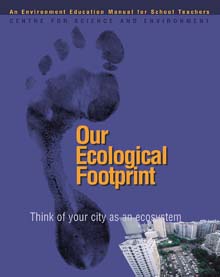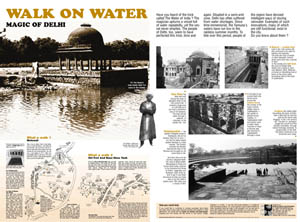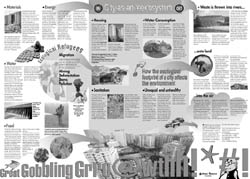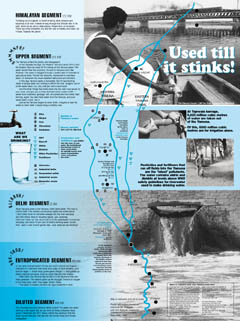RESOURCES
Children's Books
 CSE has already produced four
storybooks for children, Raindrop, Within the Well, Naina's village, Chilika Adventure and
Chipko. They have been received well by children, parents and teachers. One of the
books received an award from the National Council for Educational Research and Training. CSE has already produced four
storybooks for children, Raindrop, Within the Well, Naina's village, Chilika Adventure and
Chipko. They have been received well by children, parents and teachers. One of the
books received an award from the National Council for Educational Research and Training.
1. NAINA’S VILLAGE Published
1992, by Feisal Alkazi, Priti Jain, Jayshree Oza and Kaushalya Ramdas, cover and
illustration Neeta Gangopadhya.
The book is about two children from a city who visit a village in the hills of Uttar
Pradesh to spend their summer holidays. "Naina’s Village" narrates the
experiences of two children during their stay in the village and their exposure to Indian
rural reality.
2. THE RAINDROP* Published 1993
, by Priti Jain, Feisal Alkazi, Martha Farell and Kaushalya Ramdas, cover Stephen Marrazi,
illustration Stephen Marrazi and Reenie.
"The Raindrop" is about a village near Chandigarh in Haryana. The book tells
the story how this village was able to transform itself from a drought prone one to a food
exporting one through community efforts and scientific water- shed management
* Given an award in the XXIXth National Prize Competition for children’s
literature by NCERT (National Council of Education Research and training )
3. CHIPKO Published 1993,
Feisal Alkazi, Priti Jain, Kaushalya Ramdas, Martha Farell and Shevta Kalyanwala,
illustrations and cover Reenie.
"Chipko". The book is about a people’s movement to save their forests
and trees. Chipko movement started in 1970s in the Chamoli district of Uttar Pradesh and
saw active participation of women in the forefront.
4. THE CHILIKA LAKE ADVENTURE Published
1997, by Shveta Kalyanwala, Feisal Alkazi and Martha Farrell, edited by Srabani Sen and
Bindu Nambiar, cover and illustration by Kavita Dutta.
 The book narrates the
adventure of twelve-year-old twins Ishita and Sujai at the Chilika lake in Orissa. The
book tells about the experiences of Ishita and Sujai with local fisher folk and their
problems. It also talks degradation of the lake due silt and sewage and how the twins get
influenced by the turn of events to participate in the protest march to save the lake. The book narrates the
adventure of twelve-year-old twins Ishita and Sujai at the Chilika lake in Orissa. The
book tells about the experiences of Ishita and Sujai with local fisher folk and their
problems. It also talks degradation of the lake due silt and sewage and how the twins get
influenced by the turn of events to participate in the protest march to save the lake.
Order one of these books online!
 Our Ecolohical Footprint - A
Teachers’ Manual Our Ecolohical Footprint - A
Teachers’ Manual
Wondering what is the relationship between mainstream curriculum and
environment education?
Are you a concerned parent or an enthusiastic educator wanting to
conduct your own Ecological Footprint Project ecotour with children?
Order a copy of the Teacher’s Manual – Our
Ecological Footprint
The manual deals with issues with a perspective specific to a large
metropolis like Delhi – viz. water scarcity, water pollution, air pollution and waste
management.
If you reside in another part of the country, you, too, can link the
concept of the Ecological Footprint with that of the City-as-an Ecosystem and adapt
it to the problems and issues specific to your area.
Information has been structured so as to act as resource material for
the teacher on each ecotour as well as in the classroom. Certain sections
can be photocopied and distributed to students as additional information.
An Environment Education Manual for School Teachers
Our Ecological Footprint – Think of your city as an ecosystem.
A book that aims to bring an environmental focus to mainstream education to make it
more relevant. It helps teachers to
- Relook at the relationship between subjects in the curriculum and environment education
- Adopt methods of knitting its concepts into the regular curriculum, and
- Equip them to conduct their own Ecological Footprint Project
How can a city have a "footprint"?
The manual has been divided into 5 sections – the first is an
introduction to the concept of the city, as an ecosystem, and as the perpetrator of a ‘footprint’.
The remaining sections deal with issues predominant in urban life
– viz. pollution of river water, water harvesting, waste management and urban forests
as purifiers of air.
Information has been structured so as to act as resource material for
the teacher on each ecotour as well as in the classroom. You can even photocopy certain
sections and distribute to students as additional information.
Emphasis has been laid on learning by doing – simple activities have been
suggested which provide insights to the problems as well as solutions.
Informative Posters for
Schools
 |
These and more posters are available FREE to schools who join the Green Educator's Network. Just fill out the form and we'll get in touch with you. Additionally,
when we lead eco-tours in Delhi we give the students copies of some of the posters to take
home as well.
We also have a special series of 21 posters about traditional water harvesting systems
which we can provide.

|
 |
|